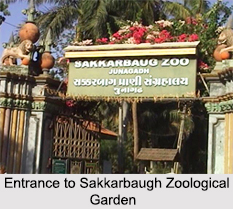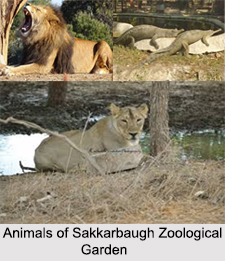 Also known as the Junagadh Zoo and Sakkarbaug Zoo, the Sakkarbaug Zoological Garden is a zoo situated in Junagadh region of Gujarat. The zoo is the home to purebred Asiatic lions which have been kept under the Indian and the International Endangered Species Captive Breeding Program. These wild Asiatic lions are facing extinction over Asia and are presently found only near Gir Forest. The Sakkarbaug Zoological Garden is known to be the third oldest zoo of the country and the oldest one of Gujarat.
Also known as the Junagadh Zoo and Sakkarbaug Zoo, the Sakkarbaug Zoological Garden is a zoo situated in Junagadh region of Gujarat. The zoo is the home to purebred Asiatic lions which have been kept under the Indian and the International Endangered Species Captive Breeding Program. These wild Asiatic lions are facing extinction over Asia and are presently found only near Gir Forest. The Sakkarbaug Zoological Garden is known to be the third oldest zoo of the country and the oldest one of Gujarat.
Features of Sakkarbaug Zoological Garden
The Sakkarbaug Zoological Garden dates back to 1863. It was established by the erstwhile Nawab of Junagad called Mohabat Khanji Babi II for saving the endangered Asiatic Lions. The year 2008 marked the formation of the Sakkarbaug Zoo Management Advisory Society for managing the zoo along with its finances. Initially the society had only 10 members. The following year in 2009 it was accredited as the only zoo of the country to shelter African cheetahs. These were acquired by the zoo in exchange of three of its lions for two pairs of cheetahs with a Singapore zoo. The purpose of the society was to raise awareness for wildlife conservation, ex-situ and in-situ conservation of Asiatic Lions and other endangered wild animals.
The fauna of the Sakkarbaug Zoological Garden enhanced in diversity further after receiving green pheasants, marmosets, Malabar giant squirrels and Indian gaur from Mysore Zoo in exchange of a couple of Asiatic lions in 2011. During this time, the zoo hosted 40 lions and lionesses. Although the zoo faced criticism owing to the size of some of its enclosures, it declared it"s up gradation for meeting the standards of the Central Zoo Authority of India (CZA). Other species found in the zoo are snakes, crocodile, wolves, deer, bear, leopards, tigers, monkeys and birds. In the year 2008, it was recorded that Sakkarbaug Zoological Garden houses 111 reptiles, 525 mammals and 597 birds which were sheltered in 100 enclosures.
 Overview of Sakkarbaug Zoological Garden
Overview of Sakkarbaug Zoological Garden
In 2003, a natural history museum was opened by the Sakkarbaug Zoo. The museum was housed in a large hall of the veterinary hospital. The main attractions amongst the exhibits of the museum include skeletons of two Asiatic lions, spotted deer, blue bull, black buck, antelope, wild boar, deer and panther. Feathers, beaks and eggs of diverse birds have also been displayed in the museum. It also showcases miniature paintings, sculptures, rare manuscripts, stuffed animals, Persian and Sanskrit inscriptions, ancient coins, archaeological items, statues and many other artefacts. The museum also houses relics of Harappan culture excavated at Intali. Seminars and travel sessions are also organized by the museum for the tourists. Apart from these, it also shows films to the visitors.
Conservation Programs in Sakkarbaug Zoological Garden
The Central Zoo Authority of India (CZA) in the year 1998 included 10 other zoos to expand the captive breeding program for Asiatic lions. The Sakkarbaug Zoo and CZA jointly manage the program. The zoo is considered the largest breeding centre. It is also involved in the breeding program for white backed vultures.
Visiting Information on Sakkarbaugh Zoological Garden
The Junagadh Junction is the nearest railway station which is merely at a distance of about 1.8 km from the zoological garden and the Keshod Airport is the closest at a distance of 41 km from the Sakkarbaugh Zoological Garden.















